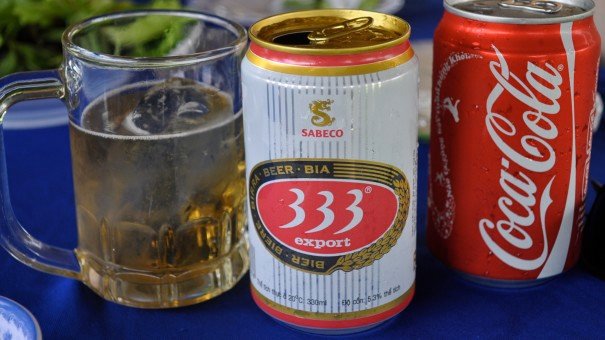
Societies Change, but the Beer Remains the Same

Societies Change, but the Beer Remains the Same
333 Beer in Saigon
Food vendors pushed three-wheeled carts down the street. Motorcyclists slowed and swerved around pedestrians who couldn’t use the sidewalk because it was filled with plastic stools and people drinking. As I walked along, drinking a can of 333 Beer, a massage girl handed me a brochure.
I sat down and ordered spring rolls outside a restaurant. Two more foreigners were stopped by the massage girl, and I could hear the tall one with a wooden cane trying to flirt with her. “Looking good,” he said. “Is the massage sexy?” When informed that it wasn’t, he said, “Then it’s not worth it.” Massage Girl slapped him with the brochure before he walked away.
That’s what Bui Vien Street, in the tourist district of Saigon in the Socialist Republic of Vietnam, looks like every night. I was there to find out what Vietnam looks like 40 years after the fall of Saigon and the final conclusion of the war. I had my beer and my notebook with me.
“Back in the day, they killed and confiscated the land from the landlords,” Quan said, referring to the Viet Cong. He had invited me to sit at a table with him and his other friend, also named Quan, and he was telling me about how his grandmother suffered during the war. “They buried my grandmother in the ground up to her neck. By the time peasants rescued her, she was paralyzed.”
I took a sip of my 333. Produced by Sabeco Brewery, a state-owned enterprise that is the largest brewer in Vietnam, 333 has its own tale of survival throughout the upheaval in Vietnam. It was created in France in 1893, and in the early 1900’s it was known as “33.” Production moved to Vietnam along with colonial powers, but it was renamed 333 after the war.
Today, the Communist Party was still firmly in power, and they made sure you knew it; along the main street there were multiple propaganda posters, with Ho Chi Minh speaking into a microphone, doves flying around him, and workers raising their arms in salute. But Saigon is a relatively open city, Quan said, and its people have entrepreneurial spirits and more tolerant social attitudes. He is a Finnish citizen now, after leaving Vietnam at age 10.
He expressed his disdain for Hanoi, the capital, saying that Hanoi is too focused on politics. “It’s too communist in Hanoi. Every morning at 7:30 they have announcements on the loudspeakers where they tell everyone the party line,” he said.
His friend Quan Nguyen agreed. We clanked our cups together and said “You!”—cheers in Vietnamese.
It’s not just Quan’s view on politics that puts him in contradiction with the government and traditional views. When I sat down and they asked me which of the foreign men standing with their backs turned to us was hottest, I gathered that the two of them were gay, traditionally a taboo in a Confucian-influenced society where continuing one’s family line is viewed as an imperative.
But even in the area of LGBT rights, Vietnam is slowly opening up. While the government doesn’t recognize same-sex marriages, it did in January rescinded the ban on publicly holding gay weddings.
Quan Nguyen had just come back from the fifth annual Viet Pride in Hanoi, where he said gay Vietnamese were out in record numbers. “We are not shy anymore,” he said. “We are coming out.”
They were playing with a dating app through the night, exchanging their views on guys, and maybe they had a date or maybe it was getting late, but they had to go. We clanked our cups one more time and went on our ways.